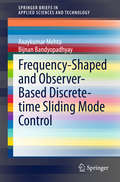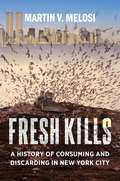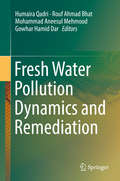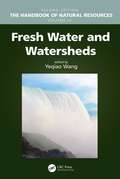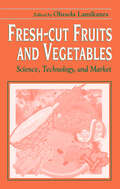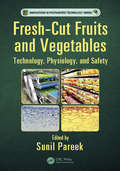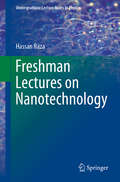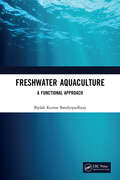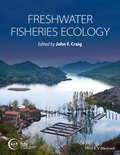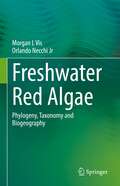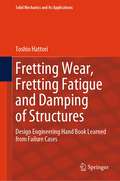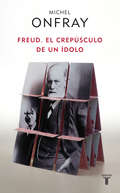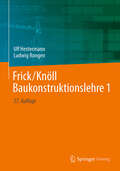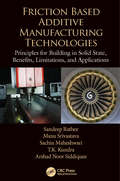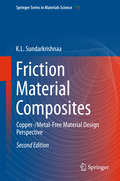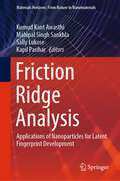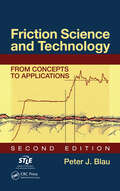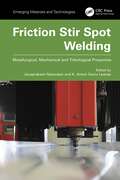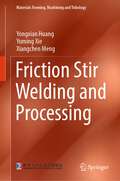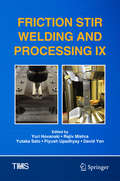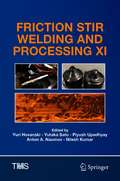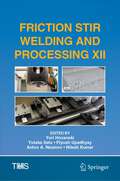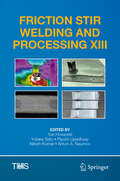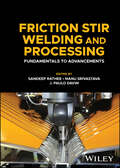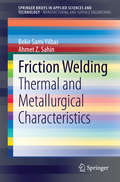- Table View
- List View
Frequency-Shaped and Observer-Based Discrete-time Sliding Mode Control
by Axaykumar Mehta Bijnan BandyopadhyayIt is well established that the sliding mode control strategy provides an effective and robust method of controlling the deterministic system due to its well-known invariance property to a class of bounded disturbance and parameter variations. Advances in microcomputer technologies have made digital control increasingly popular among the researchers worldwide. And that led to the study of discrete-time sliding mode control design and its implementation. This brief presents, a method for multi-rate frequency shaped sliding mode controller design based on switching and non-switching type of reaching law. In this approach, the frequency dependent compensator dynamics are introduced through a frequency-shaped sliding surface by assigning frequency dependent weighing matrices in a linear quadratic regulator (LQR) design procedure. In this way, the undesired high frequency dynamics or certain frequency disturbance can be eliminated. The states are implicitly obtained by measuring the output at a faster rate than the control. It is also known that the vibration control of smart structure is a challenging problem as it has several vibratory modes. So, the frequency shaping approach is used to suppress the frequency dynamics excited during sliding mode in smart structure. The frequency content of the optimal sliding mode is shaped by using a frequency dependent compensator, such that a higher gain can be obtained at the resonance frequencies. The brief discusses the design methods of the controllers based on the proposed approach for the vibration suppression of the intelligent structure. The brief also presents a design of discrete-time reduced order observer using the duality to discrete-time sliding surface design. First, the duality between the coefcients of the discrete-time reduced order observer and the sliding surface design is established and then, the design method for the observer using Riccati equation is explained. Using the proposed method, the observer for the Power System Stabilizer (PSS) for Single Machine Innite Bus (SMIB) system is designed and the simulation is carried out using the observed states. The discrete-time sliding mode controller based on the proposed reduced order observer design method is also obtained for a laboratory experimental servo system and veried with the experimental results.
Fresh Kills: A History of Consuming and Discarding in New York City
by Martin V. MelosiFresh Kills—a monumental 2,200-acre site on Staten Island—was once the world’s largest landfill. From 1948 to 2001, it was the main receptacle for New York City’s refuse. After the 9/11 attacks, it reopened briefly to receive human remains and rubble from the destroyed Twin Towers, turning a notorious disposal site into a cemetery. Today, a mammoth reclamation project is transforming the landfill site, constructing an expansive park three times the size of Central Park.Martin V. Melosi provides a comprehensive chronicle of Fresh Kills that offers new insights into the growth and development of New York City and the relationship among consumption, waste, and disposal. He traces the metamorphoses of the landscape, following it from salt marsh to landfill to cemetery and looks ahead to the future park. By centering the problem of solid-waste disposal, Melosi highlights the unwanted consequences of mass consumption. He presents the Fresh Kills space as an embodiment of massive waste, linking consumption to the continuing presence of its discards. Melosi also uses the landfill as a lens for understanding Staten Island’s history and its relationship with greater New York City. The first book on the history of the iconic landfill, Fresh Kills unites environmental, political, and cultural history to offer a reflection on material culture, consumer practices, and perceptions of value and worthlessness.
Fresh Water Pollution Dynamics and Remediation
by Humaira Qadri Rouf Ahmad Bhat Mohammad Aneesul Mehmood Gowhar Hamid DarFreshwater is a finite resource and is being deteriorated directly and indirectly by anthropogenic pressures. Preserving the quality and availability of freshwater resources is becoming one of the most pressing environmental challenges on the international horizon. To ensure the preservation as well as availability of freshwater resources, there is a need to understand the ecology of the freshwater systems, pollution problems, their impacts, restoration techniques to be opted and the conservation measures. In this backdrop the present book on ‘Freshwater Pollution Dynamics and Remediation’ has been compiled. The book provides an understanding about the present state of art, pollution impacts including the changes in the environmental quality as well as the shift in the aquatic biological communities of the fragile freshwater ecosystems. Besides, the impact of deteriorating quality of the freshwater ecosystems on the animal and human health is also discussed in detail. This book provides a comprehensive account of the techniques based on updated research in biotechnology, bio-remediation, phyto-remediation and nano-bioremediation. The role of biosorpers and biofilms as a remediation tool has also been detailed. The book is a ready reference for researchers, scientists and educators who are involved in the freshwater pollution, remediation and management studies. The book editors with an expertise in diverse research fields in freshwater ecosystems have congregated the most inclusive research accounts on the freshwater pollution and remediation and thus developed a repository of diverse knowledge on the subject
Fresh Water and Watersheds
by Yeqiao WangAuthored by world-class scientists and scholars, The Handbook of Natural Resources, Second Edition, is an excellent reference for understanding the consequences of changing natural resources to the degradation of ecological integrity and the sustainability of life. Based on the content of the bestselling and CHOICE-awarded Encyclopedia of Natural Resources, this new edition demonstrates the major challenges that the society is facing for the sustainability of all well-being on the planet Earth. The experience, evidence, methods, and models used in studying natural resources are presented in six stand-alone volumes, arranged along the main systems of land, water, and air. It reviews state-of-the-art knowledge, highlights advances made in different areas, and provides guidance for the appropriate use of remote sensing and geospatial data with field-based measurements in the study of natural resources. Volume 4, Fresh Water and Watersheds, covers fresh water and watersheds, their health and conservation, protection, and management. Organized for ease of reference, it provides fundamental information on groundwater storage, water quality, supply and balance, and water resource vulnerability. New in this edition are discussions on water footprint assessment, water surface dynamics, and water management on a global scale. Understanding the conditions of watersheds is crucial for restoring areas with degraded water quality as well as protecting healthy waters from emerging problems. This volume demonstrates the key processes, methods, and models used through several practical case studies from around the world. Written in an easy-to-reference manner, The Handbook of Natural Resources, Second Edition, as individual volumes or as a complete set, is an essential reading for anyone looking for a deeper understanding of the science and management of natural resources. Public and private libraries, educational and research institutions, scientists, scholars, and resource managers will benefit enormously from this set. Individual volumes and chapters can also be used in a wide variety of both graduate and undergraduate courses in environmental science and natural science at different levels and disciplines, such as biology, geography, earth system science, and ecology.
Fresh-Cut Fruits and Vegetables: Science, Technology, and Market
by Olusola LamikanraFresh-cut Fruits and Vegetables: Science, Technology, and Market provides a comprehensive reference source for the emerging fresh-cut fruits and vegetables industry. It focuses on the unique biochemical, physiological, microbiological, and quality changes in fresh-cut processing and storage and on the distinct equipment design, packaging requiremen
Fresh-Cut Fruits and Vegetables: Technology, Physiology, and Safety (Innovations in Postharvest Technology Series)
by Sunil PareekBecause they meet the needs of today’s consumers, fresh-cut plant products are currently one of the hottest commodities in the food market of industrialized countries. However, fresh-cut produce deteriorates faster than the correspondent intact produce. The main purpose of Fresh-Cut Fruits and Vegetables: Technology, Physiology, and Safety is to provide helpful guidelines to the industry for minimizing deterioration, keeping the overall quality, and lengthening the shelf life. It provides an integrated and interdisciplinary approach for accomplishing the challenges, where raw materials, handling, minimal processing, packaging, commercial distribution, and retail sale must be well managed. It covers technology, physiology, quality, and safety of fresh-cut fruits and vegetables. In this book, the chapters follow a logical sequence analyzing most of the important factors affecting the main characteristics of fresh-cut horticultural products. The most relevant technologies to prevent deterioration and improve final overall quality of fresh-cut commodities are described in detail. This book covers the basics of the subject from quality preservation, nutritional losses, physiology, and safety to industry-oriented advancements in sanitization, coatings, and packaging. It examines such novel preservation technologies as edible coatings, antimicrobial coatings, natural antimicrobials, gum arabic coatings, and pulsed light treatments. Minimal processing design and industrial equipment are also reviewed. With its international team of contributors, this book will be an essential reference work both for professionals involved in the postharvest handling of fresh-cut and minimally processed fruits and vegetables and for academic and researchers working in the area.
Freshman Lectures on Nanotechnology (Undergraduate Lecture Notes in Physics)
by Hassan RazaNanotechnology is the art, science, and engineering of designing materials, devices, and systems at the nanoscale from bottom-up and/or top-down approaches. The material properties at the nanoscale are governed by quantum mechanics, and hence are drastically different than those at the macro/micro scale. It is thus no surprise, that nanotechnology has led to a scientific and technological revolution. This book provides a gentle introduction to the field of nanotechnology for first-year undergraduate students. It not only covers the fundamental scientific concepts in a tutorial fashion, but also provides an overview of applications in nanoelectronics, spintronics, nanophotonics, nanofabrication and nanocharacterization. End of chapter research assignments focus on nanomanufacturing, computing and communication, renewable energy, defense applications, food processing and agriculture, automobile and aerospace technology, nanobiotechnology and bionanotechnology, industrial and consumer applications. Finally, the topics related to safety, health, and societal impact of nanotechnology are discussed.
Freshwater Aquaculture: A Functional Approach
by Biplab Kumar BandyopadhyayFreshwater Aquaculture – the study of breeding, rearing and commercialization of organisms, fish in particular, which inhabit in fresh water. Even though there remains some fragmentary information regarding the history of development of aquaculture in India but those seem to be far from being complete. In the present communication, the same has been given elaborately. The book concentrates on the culture technology of commercially important fresh water fishes. Various types of culture techniques including Aquaponics, Bioflocs, Recirculatory Aquaculture Systems (RAS) apart from the conventional Cage culture, Pen culture, Integration of fish culture with other crops viz. paddy, vegetables, dairy, piggery, poultry etc. have been dispensed in detail. Note: T&F does not sell or distribute the Hardback in India, Pakistan, Nepal, Bhutan, Bangladesh and Sri Lanka.
Freshwater Fisheries Ecology
by John F. CraigInland fisheries are vital for the livelihoods and food resources of humans worldwide but their importance is underestimated, probably because large numbers of small, local operators are involved. Freshwater Fisheries Ecology defines what we have globally, what we are going to lose and mitigate for, and what, given the right tools, we can save. To estimate potential production, the dynamics of freshwater ecosystems (rivers, lakes and estuaries) need to be understood. These dynamics are diverse, as are the earth?s freshwater fisheries resources (from boreal to tropical regions), and these influence how fisheries are both utilized and abused. Three main types of fisheries are illustrated within the book: artisanal, commercial and recreational, and the tools which have evolved for fisheries governance and management, including assessment methods, are described. The book also covers in detail fisheries development, providing information on improving fisheries through environmental and habitat evaluation, enhancement and rehabilitation, aquaculture, genetically modified fishes and sustainability. The book thoroughly reviews the negative impacts on fisheries including excessive harvesting, climate change, toxicology, impoundments, barriers and abstractions, non-native species and eutrophication. Finally, key areas of future research are outlined. Freshwater Fisheries Ecology is truly a landmark publication, containing contributions from over 100 leading experts and supported by the Fisheries Society of the British Isles. The global approach makes this book essential reading for fish biologists, fisheries scientists and ecologists and upper level students in these disciplines. Libraries in all universities and research establishments where biological and fisheries sciences are studied and taught should have multiple copies of this hugely valuable resource. About the EditorJohn Craig is Editor-in-Chief of the Journal of Fish Biology and has an enormous range of expertise and a wealth of knowledge of freshwater fishes and their ecology, having studied them around the globe, including in Asia, North America, Africa, the Middle East and Europe. His particular interests have been in population dynamics and life history strategies. He is a Fellow of the Linnean Society of London and the Royal Society of Biology.
Freshwater Red Algae: Phylogeny, Taxonomy and Biogeography
by Morgan L Vis Orlando Necchi JrThis book presents the phylogeny, taxonomy and biogeography of freshwater red algae. Its content is divided into five chapters. The first chapter provides a brief history of freshwater red algal research, habits and collecting methods, general biogeographic trends and an overview of the taxonomic/phylogenetic placement of freshwater taxa. The other four chapters are taxonomic treatments of non-marine red algae based on taxonomic levels, i.e. classes within the phylum Rhodophyta, orders within each class, families within each order, and genera within each family. Descriptions, phylogenetic data (including numerous trees), geographic range (maps for most species) and dichotomous keys for identification are presented. Comprehensive data are provided for more than 220 species.
Fretting Wear, Fretting Fatigue and Damping of Structures: Design Engineering Hand Book Learned from Failure Cases (Solid Mechanics and Its Applications #276)
by Toshio HattoriThis book provides a comprehensive overview of the mechanical distinctions between fretting damage under axial or bending external forces and fretting damage under a torsional load. It emphasizes the importance of studying practical accident cases to efficiently acquire technical skills. The book is structured around the fundamental technologies of material science, tribology, and mechanics, which are vital for understanding and addressing technical issues. The author has incorporated all fretting countermeasure technologies, which were previously often sensory and empirical in nature, and repositioned them as technologies grounded in fundamental principles. The book proposes an economical approach to product operation that maintains reliability by integrating not only design technology but also maintenance practices. It delves into specific materials, such as titanium alloys and aluminum alloys, which have seen increased use for weight reduction in industries like aerospace. In this book, “Critical Distance Stress Theory” that can easily derive the fatigue limit and fatigue life of the stress singular field at the contact edge was presented. As a result, the fretting fatigue strength and life can be predicted from the same FEM stress analysis as the normal stress concentration part. And finally, introducing a novel fretting mechanical model, the book focuses on scenarios where pressure force (N) and repeated tangential force (F) are applied to two planar objects, with the tangential force being transmitted solely through friction at the contact surface. This model finds relevance in turbine blade connection structures, among other applications. The author references Asai's research example, which encompasses fretting mechanical analysis, fretting wear evaluation, fatigue assessment, and structural damping evaluation using this model.
Freud: El crepúsculo de un ídolo
by Michel OnfrayEl prestigioso filósofo francés Michel Onfray, autor del best seller Tratado de ateología, ha escrito un ataque virulento contra el psicoanálisis, y en particular contra el freudismo, vehementemente argumentado y que ha creado una gran polémica en Francia. Onfray parte en este libro de una idea simple pero radical: Freud quiso construir una «ciencia» y no lo consiguió; quiso «probar» que el inconsciente tenía sus leyes, su lógica intrínseca, sus protocolos de experimentación, y usó todos los medios a su alcance para adornar el psicoanálisis con la apariencia de lo científico. Con gran rigor, Michel Onfray reexamina las obras de Freud, así como su biografía, para desvelar sus inconsistencias y contradicciones y ofrecer una conclusión implacable: el psicoanálisis no es más que el producto de influencias de la psicología, de la literatura y de la filosofía, pero en ningún caso es la ciencia a la que aspiraba su fundador. La crítica ha dicho...«Un ensayo potente, inteligente e inquietante, escrito de manera simple y directa, hábilmente argumentado y organizado en torno a una tesis sistemáticamente desarrollada.»Robert Maggiori, Libération «Un libro tan contundente como Tratado de ateología.»Livres Hebdo «No solo importante sino también apasionante. Este libro ya es un clásico. Como dice Onfray, ya era hora de sacar a Freud de la leyenda para introducirlo en la historia, donde será discutido, atacado y, por supuesto, defendido.»Le Point «Dejando atrás el freudismo de postal, Onfray se entrega a la deconstrucción de un sistema.»L'Express «Un gran incendio mediático.»Paris Match
Frick/Knöll Baukonstruktionslehre 1
by Ulf Hestermann Ludwig RongenSeit über einem Jahrhundert gibt der „Frick/Knöll“ Generationen von Architekten und Bauingenieuren einen umfassenden Einblick in die Baukonstruktionslehre. Vom Fundament über den Innenausbau bis zum Dach bietet das Standardwerk der Baukonstruktionslehre kompaktes Grundwissen und berücksichtigt aktuelle Neuentwicklungen und die immer stärker anwachsende Zahl von Normen, Verordnungen und anderen Baubestimmungen. Der „Frick/Knöll“ ist damit ein unentbehrlicher und zuverlässiger Begleiter für jeden Studierenden und Praktiker.In der vollständig überarbeiteten und aktualisierten 37. Auflage werden neben der Einarbeitung des aktuellen Standes der Normung und praxisrelevanten Richtlinien zeitgemäße Konstruktionsprinzipien unter zunehmender Berücksichtigung des insgesamt nachhaltigen wie energieeffizienten, ökologisch unbedenklichen und ressourcenschonenden Planens und Bauens behandelt.Die Frick/Knöll Baukonstruktionslehre ist nach wie vor das Nachschlagewerk zu allen baukonstruktiven Fragestellungen vom Fundament über den Innenausbau bis zum Dach.
Friction Based Additive Manufacturing Technologies: Principles for Building in Solid State, Benefits, Limitations, and Applications
by Sandeep Rathee Manu Srivastava Sachin Maheshwari T. K. Kundra Arshad SiddiqueeCurrently, most of the major commercial metal additive manufacturing (MAM) techniques rely on liquid phase processing. The liquid to solid phase transformations in these techniques results in microstructural issues and defects which in turn tantamount to inferior properties of fabricated build. Friction based additive manufacturing technologies are solid state processing techniques which work on the principles of friction based joining processes and layer by layer additive manufacturing. This book primarily addresses the basic understanding of seven friction based additive manufacturing techniques. These techniques include additive manufacturing methods based on rotary friction welding, linear friction welding, friction deposition, friction surfacing, friction stir additive manufacturing, friction assisted seam welding and additive friction stir. The principle of operations, benefits, limitations and recent developments of each technique has been described. It covers potentional and probable applications of each technique through review of various experimental studies. Features Targets friction based solid state additive manufacturing of metallic materials Describes principle of operation of seven friction based additive manufacturing techniques Reviews latest trends of these processes via experimental studies Describes benefits and limitations of each technique Covers current and probable applications of these techniques
Friction Material Composites
by K. L. SundarkrishnaaFriction Material Composites is the first volume of the five volumes which strongly educates and updates engineers and other professionals in braking industries, research and test labs. It explains besides the formulation of design processes and its complete manufacturing input. This book gives an idea of mechanisms of friction and how to control them by designing .The book is useful for designers of automotive, rail and aero industries for designing the brake systems effectively with the integration of friction material composite design which is critical. It clearly emphasizes the driving safety and how serious designers should select the design input. The significance of friction material component like brake pad or a liner as an integral part of the brake system of vehicles is explained. AFM pictures at nanolevel illustrate broadly the explanations given.
Friction Ridge Analysis: Applications of Nanoparticles for Latent Fingerprint Development (Materials Horizons: From Nature to Nanomaterials)
by Kumud Kant Awasthi Mahipal Singh Sankhla Sally Lukose Kapil PariharThe book presents emerging techniques for the development of latent fingerprint on various surfaces using nanotechnology. It explores the use of nanoparticles for the development of fingerprints. Various topics covered in this book include chemistry of nanomaterials for finger printing, quantum dots in fingerprinting, florescent nanoparticles in fingerprinting, nanocomposite and hybrid materials for fingerprints, carbon-based nanomaterial, silver and gold nanoparticles development of fingerprint, zinc oxide nanoparticles, silica nanoparticles for development of fingerprints, etc. Given the contents, the book will be highly useful for the students, researchers and professionals working in the areas of forensic science and nanotechnology.
Friction Science and Technology: From Concepts to Applications, Second Edition
by Peter J. Blau"Should have broad appeal in many kinds of industry, ranging from automotive to computers-basically any organization concerned with products having moving parts!"-David A. Rigney, Materials Science and Engineering Department, Ohio State University, Columbus, USAIn-Depth Coverage of Frictional ConceptsFriction affects so many aspects of daily l
Friction Stir Spot Welding: Metallurgical, Mechanical and Tribological Properties (Emerging Materials and Technologies)
by Jeyaprakash Natarajan K. Anton Savio LewiseFriction Stir Spot Welding offers an introduction to friction stir spot welding (FSSW) between both similar and dissimilar metals and materials. It explains the impact of the interlayer in FSSW of different metals with regard to mechanical, metallurgical, wear, thermo-mechanical, and chemical characteristics.Emphasizing the impact of interlayer on FSSW of different metals, this book discusses the influence of the interlayer in the process as a new technique. Using aerospace and automotive structures as examples, the book explains how their components successfully employ materials like dissimilar aluminium alloys, yielding increased electrical, thermal, and mechanical characteristics. It also considers the reinforcement, effect of tool geometry, wettability, and corrosion behavior of joints.This book is intended for mechanical, materials, and manufacturing professionals, researchers, and engineers working in the field of FSSW.
Friction Stir Welding and Processing (Materials Forming, Machining and Tribology)
by Yongxian Huang Yuming Xie Xiangchen MengThis book introduces the principles and characteristics of friction stir welding and processing. Based on the inherent issues of friction stir welding, such as back support, weld thinning, and keyhole defects, the book summarizes innovative technologies related to solution strategies and presents a wide range of examples. It introduces the advantages and joining mechanism of friction stir welding in the joining of dissimilar materials and explains the importance of combining metallurgical bonding and mechanical joining. It also includes the characteristics of friction stir processing in terms of microstructure refinement, mechanical properties, surface modification, and the preparation of composites. This book is of interest to a broad readership in various fields of materials science and engineering.
Friction Stir Welding and Processing IX
by Yuri Hovanski Rajiv Mishra Yutaka Sato Piyush Upadhyay David YanThis books presents a current look at friction stir welding technology from application to characterization and from modeling to R&D. It is a compilation of the recent progress relating to friction stir technologies including derivative technologies, high-temperature applications, industrial applications, dissimilar alloy/materials, lightweight alloys, simulation, and characterization. With contributions from leaders and experts in industry and academia, this will be a comprehensive source for the field of Friction Stir Welding and Processing.
Friction Stir Welding and Processing XI (The Minerals, Metals & Materials Series)
by Nilesh Kumar Yuri Hovanski Yutaka Sato Piyush Upadhyay Anton A. NaumovThis collection presents fundamentals and the current status of friction stir welding (FSW) and solid-state friction stir processing of materials, and provides researchers and engineers with an opportunity to review the current status of the friction stir related processes and discuss the future possibilities. Contributions cover various aspects of friction stir welding and processing including their derivative technologies. Topics include but are not limited to: • derivative technologies • high-temperature lightweight applications • industrial applications • dissimilar alloys and/or materials • controls and nondestructive examination • simulation • characterization
Friction Stir Welding and Processing XII (The Minerals, Metals & Materials Series)
by Nilesh Kumar Yuri Hovanski Yutaka Sato Piyush Upadhyay Anton A. NaumovThis collection presents fundamentals and the current status of friction stir welding (FSW) and solid-state friction stir processing of materials and provides researchers and engineers with an opportunity to review the current status of the friction stir related processes and discuss the future possibilities. Contributions cover various aspects of friction stir welding and processing including their derivative technologies. Topics include, but are not limited to:• Derivative technologies • High-temperature applications • Industrial applications • Dissimilar alloys and/or materials • Lightweight alloys • Simulation • Characterization • Non-destructive examination techniques
Friction Stir Welding and Processing XIII (The Minerals, Metals & Materials Series)
by Nilesh Kumar Yuri Hovanski Yutaka Sato Piyush Upadhyay Anton A. NaumovThis volume presents fundamentals and the current status of friction stir welding (FSW) and solid-state friction stir processing of materials and provides researchers and engineers with an opportunity to review the current status of the friction stir related processes and discuss the future possibilities. Contributions cover various aspects of friction stir welding and processing including their derivative technologies. Topics include but are not limited to: Additive friction stir technologies Friction stir extrusion technologies High temperature applications Industrial applications Friction stir spot technologies Dissimilar alloys and materials Lightweight alloys Simulation, characterization, and non-destructive examination techniques
Friction Stir Welding and Processing: Fundamentals to Advancements
by J. Paulo Davim Sandeep Rathee Manu SrivastavaA single source of information on the fundamental concepts and latest research applications of friction stir welding and processing Friction Stir Welding and Processing: Fundamentals to Advancements provides concise yet comprehensive coverage of the field of friction stir welding, with an eye toward future research directions and applications. Throughout the book, case studies provide real-world context and highlight applications for various engineering sectors. With contributions from an array of leaders in the field, Friction Stir Welding and Processing provides readers with a single source of information on all aspects of FSW and FSP. After explaining the fundamentals of friction stir welding (FSW) and its variants, the book discusses composite fabrication techniques using friction stir processing (FSP). Different types of friction techniques are covered, as is the equipment used. Detailed characterization of samples and composites are included. Additional topics discussed include the impact of FSW on the economics of production, methods for coupling FSW/FSP with additive manufacturing, composite fabrication, and process-property relationships. Master the basic concepts of friction stir welding and its variants Discover the role of FSW in developing hybrid manufacturing techniques Follow case studies that connect theoretical concepts to real-world experimental results Learn from contributions from an array of global thought leaders in the field This is a valuable compendium on the topic for engineers and designers who utilize welding and advanced manufacturing across industries, as well as graduate students and post-graduate researchers who are exploring new friction stir welding applications.
Friction Welding
by Bekir Sami Yilbas Ahmet Z. SahinThis book provides insight into the thermal analysis of friction welding incorporating welding parameters such as external, duration, breaking load, and material properties. The morphological and metallurgical changes associated with the resulting weld sites are analysed using characterization methods such as electron scanning microscope, energy dispersive spectroscopy, X-ray Diffraction, and Nuclear reaction analysis.
